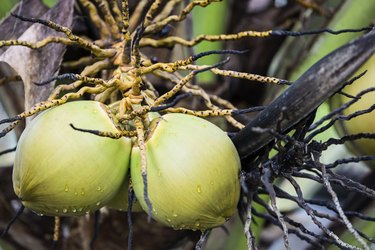
The coconut palm (Cocos nucifera) is arguably the tree that is most emblematic of the tropical landscape. The towering palms make a bold statement in the landscape, but their sensitivity to cold and disease can make them a challenge for the home gardener.
Growth and Habitat
Video of the Day
Originally native to tropical Pacific islands, coconut palms are tall, unbranching trees crowned with arching fronds that can each reach a length of up to 20 feet. They're impressive specimens that provide a strong focal point in the landscape. They function well as street trees, although they should be pruned to remove fruit if they're near roads or walkways to reduce the danger from falling coconuts.
Video of the Day
Coconut palms are winter hardy in U.S. Department of Agriculture plant hardiness zones 10 to 12. The trees are extremely sensitive to cold, and they can suffer injury if they're exposed to temperatures of 40 degrees Fahrenheit or less. Temperatures below 35 degrees F may kill the tree, and fruit production isn't reliable unless minimum temperatures remain above 64 degrees.
The trees also do best in humid climates and do not tolerate drought. In the United States, they are best suited to the climates of Hawaii, south Florida and extreme southern Texas.
Tall Types
Full-size varieties of coconut palm are tall trees that can reach heights between 50 and 100 feet, and the spread of fronds at the tree's crown may be as wide as 40 feet. Common tall varieties include "Jamaica Tall" (Cocos nucifera "Jamaica Tall"), "Panama Tall" (Cocos nucifera "Panama Tall") and the "Maypan" hybrid (Cocos nucifera "Maypan"). Tall types function best as backdrop plantings, shade trees or street trees.
Dwarf Types
Dwarf and semi-dwarf cultivars of the coconut palm reach a maximum height that's much shorter than that of full-height varieties. The "Malayan Dwarf" variety (Cocos nucifera "Malayan Dwarf") is a semi-dwarf that typically grows to between 30 and 60 feet tall, with a crown spread of between 15 and 25 feet. The fronds of "Malayan Dwarf" are also smaller than those of tall types, reaching a length of only about 3 feet. Dwarf trees can be used in the landscape as specimen trees in spaces too confined to accommodate a tall palm.
Variations Between Cultivars
Coconut cultivars vary in characteristics such as the shape of their trunks, their growth rates and the color of their fruit. "Panama Tall," for example, is characterized by its swollen trunk base, while the "Malayan Dwarf" has an unswollen trunk that tends to be straighter than that of "Jamaica Tall"; its fruit is also sometimes yellow or golden, in contrast to the bronze-colored ripe fruit of "Jamiaca Tall" and the "Maypan" hybrid.
Disease Resistance
Coconut palms are especially vulnerable to a disease called lethal yellowing, an incurable infection caused by a microorganism called phytoplasma. The disease causes, initially, a yellowing of the leaves, and the entire tree will likely die within six months after the first appearance of symptoms.
"Jamaica Tall" trees are especially susceptible to lethal yellowing, but all tall types are vulnerable and are not recommended for planting in gardens in areas where the disease is prevalent.
The "Malayan Dwarf" and "Maypan" varieties were once thought to be resistant to the disease, but long-term studies by the University of Florida have concluded that these varieties are only moderately more resistant than is "Jamaica Tall." A dwarf variety commonly called "Fiji Dwarf" shows early promise in terms of its resistance, but it is not yet widely available.